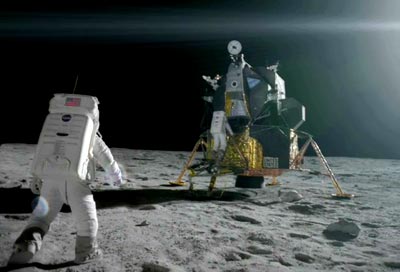Preview: Magnificent Desolationby Jeff Foust
|
| “Tom said, ‘I want to put people on the Moon. I want a you-are-there feeling,’” Cowen recalled. |
Not only do Hanks and Cowen want people to feel like they’re on the Moon, they wanted the vignettes from the various Apollo missions to be as accurate as possible. “Every shot we did on the lunar surface we were very, very careful and spent months researching it,” Cowen noted. “So if we were on Apollo 15 and at the edge of Hadley Rille, and I decided I wanted to get a shot of Dave Scott and Jim Irwin standing on the edge of the rille, we sort of GPS’ed our way into it, and used all of the actual NASA EVA photographs as our background landscapes.”
To aid in this quest for accuracy the film’s producers called upon a number of resources, including thousands of Apollo photographs from the NASA archives, the Apollo Lunar Surface Journal (ALSJ), and a core team of researchers, not to mention Hanks himself. “I gotta tell you, this guy [Hanks] showed up each and every day, and sat there with our researchers, going through all of the transmissions and the footage,” said Cowen. “It was like a kid in a candy store. It was really exciting to see.” Hanks was no amateur, either: Cowen described how Hanks won a trivia contest with the research staff by knowing the model number of the Teflon thread used to sew patches onto the lunar spacesuits.
The movie combined nine weeks’ worth of live-action shots on a soundstage with considerable use of computer-generated imagery (CGI) to make the visuals look as realistic as possible. At one point early in the shooting, Cowen said they realized the dust being kicked up by the actors in the spacesuits wasn’t behaving as it would on the Moon: the air was creating clouds of dust, instead of the ballistic arcs of dust particles that would be seen on the Moon. So, they had to scrape the dust off of the entire surface and use CGI instead for a more realistic look. That quest for realism extended to the entire crew, Cowen said, even those who weren’t space enthusiasts. “Everybody got into trying to make it as photorealistic as they could,” he said.
Attention to detail is one thing, but it is sterile without a compelling narrative of some kind to bind it together. The short scenes shown at the screening—Aldrin descending from the ladder on Apollo 11, Scott and Irwin and Hadley Rille, and Charlie Duke leaving a memento on the surface—don’t provide enough to tell how Cowen and Hanks plan to tell the story. “The story is, quite simply, the Apollo missions. It’s not how we got to the Moon, it is not how we got back, it is just what took place on the Moon,” said Cowen. He added that Hanks described the movie, when he was pitching it to IMAX and NASA, as “the ultimate road trip movie”.
| “The story is, quite simply, the Apollo missions. It’s not how we got to the Moon, it is not how we got back, it is just what took place on the Moon,” said Cowen. |
The challenge of making such a movie, where all the action takes place on the lunar surface, is that the actors are hidden within their spacesuits, making it difficult to display emotion or even to communicate. Cowen said that they plan to use a combination of visual effects and music to provide the emotion that can’t be displayed with the astronauts’ faces hidden. The movie’s dialogue will be taken directly from the ALSJ, with additional quotes from the astronauts voiced over (“Ken Burns style”, Cowen explained) by a number of actors, including Gary Sinise, Morgan Freeman, Matt Damon, and Paul Newman.
How compelling a movie that makes remains to be seen. However, it was clear, both from the clips shown in Las Vegas and Cowen’s description, that Magnificent Desolation captured at least some of the spirit, some of the magic, of the Apollo missions. Cowen described how Dave Scott, who served as a technical consultant for the movie, was overseeing one of the last scenes of the film, where a series of footprints leads to the lunar module for Apollo 17. A crewmember was about to don the boots to make those prints, when Cowen turned to Scott and asked, “What do you think? One more time, for old times’ sake?” The response: “Don’t mind if I do.” Scott put on the boots and made the footprints “with the true stride of an Apollo astronaut.” Scott, Cowen recalled, then turned and said, “Like riding a bike.”
